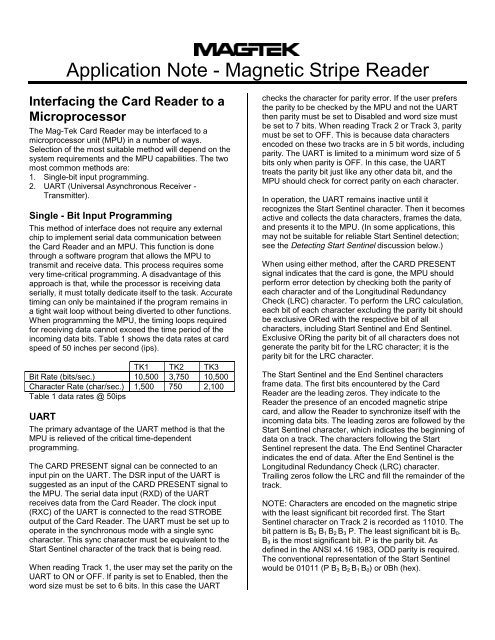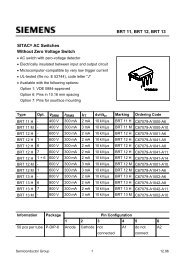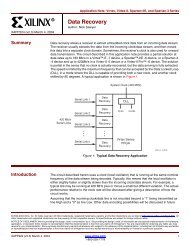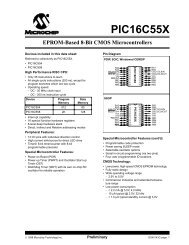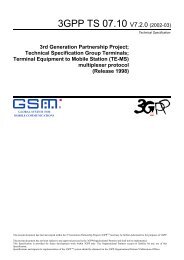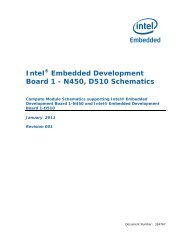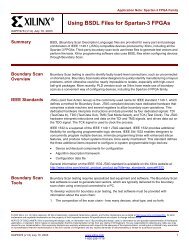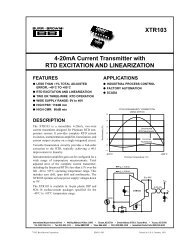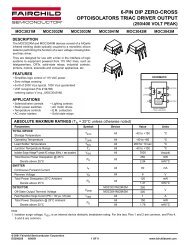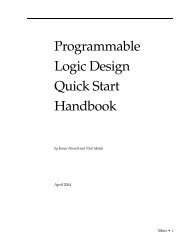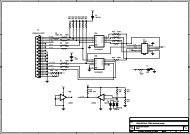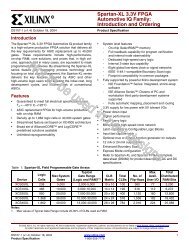Application Note - Magnetic Stripe Reader
Application Note - Magnetic Stripe Reader
Application Note - Magnetic Stripe Reader
Create successful ePaper yourself
Turn your PDF publications into a flip-book with our unique Google optimized e-Paper software.
<strong>Application</strong> <strong>Note</strong> - <strong>Magnetic</strong> <strong>Stripe</strong> <strong>Reader</strong><br />
Interfacing the Card <strong>Reader</strong> to a<br />
Microprocessor<br />
The Mag-Tek Card <strong>Reader</strong> may be interfaced to a<br />
microprocessor unit (MPU) in a number of ways.<br />
Selection of the most suitable method will depend on the<br />
system requirements and the MPU capabilities. The two<br />
most common methods are:<br />
1. Single-bit input programming.<br />
2. UART (Universal Asynchronous Receiver -<br />
Transmitter).<br />
Single - Bit Input Programming<br />
This method of interface does not require any external<br />
chip to implement serial data communication between<br />
the Card <strong>Reader</strong> and an MPU. This function is done<br />
through a software program that allows the MPU to<br />
transmit and receive data. This process requires some<br />
very time-critical programming. A disadvantage of this<br />
approach is that, while the processor is receiving data<br />
serially, it must totally dedicate itself to the task. Accurate<br />
timing can only be maintained if the program remains in<br />
a tight wait loop without being diverted to other functions.<br />
When programming the MPU, the timing loops required<br />
for receiving data cannot exceed the time period of the<br />
incoming data bits. Table 1 shows the data rates at card<br />
speed of 50 inches per second (ips).<br />
TK1 TK2 TK3<br />
Bit Rate (bits/sec.) 10,500 3,750 10,500<br />
Character Rate (char/sec.) 1,500 750 2,100<br />
Table 1 data rates @ 50ips<br />
UART<br />
The primary advantage of the UART method is that the<br />
MPU is relieved of the critical time-dependent<br />
programming.<br />
The CARD PRESENT signal can be connected to an<br />
input pin on the UART. The DSR input of the UART is<br />
suggested as an input of the CARD PRESENT signal to<br />
the MPU. The serial data input (RXD) of the UART<br />
receives data from the Card <strong>Reader</strong>. The clock input<br />
(RXC) of the UART is connected to the read STROBE<br />
output of the Card <strong>Reader</strong>. The UART must be set up to<br />
operate in the synchronous mode with a single sync<br />
character. This sync character must be equivalent to the<br />
Start Sentinel character of the track that is being read.<br />
When reading Track 1, the user may set the parity on the<br />
UART to ON or OFF. If parity is set to Enabled, then the<br />
word size must be set to 6 bits. In this case the UART<br />
checks the character for parity error. If the user prefers<br />
the parity to be checked by the MPU and not the UART<br />
then parity must be set to Disabled and word size must<br />
be set to 7 bits. When reading Track 2 or Track 3, parity<br />
must be set to OFF. This is because data characters<br />
encoded on these two tracks are in 5 bit words, including<br />
parity. The UART is limited to a minimum word size of 5<br />
bits only when parity is OFF. In this case, the UART<br />
treats the parity bit just like any other data bit, and the<br />
MPU should check for correct parity on each character.<br />
In operation, the UART remains inactive until it<br />
recognizes the Start Sentinel character. Then it becomes<br />
active and collects the data characters, frames the data,<br />
and presents it to the MPU. (In some applications, this<br />
may not be suitable for reliable Start Sentinel detection;<br />
see the Detecting Start Sentinel discussion below.)<br />
When using either method, after the CARD PRESENT<br />
signal indicates that the card is gone, the MPU should<br />
perform error detection by checking both the parity of<br />
each character and of the Longitudinal Redundancy<br />
Check (LRC) character. To perform the LRC calculation,<br />
each bit of each character excluding the parity bit should<br />
be exclusive ORed with the respective bit of all<br />
characters, including Start Sentinel and End Sentinel.<br />
Exclusive ORing the parity bit of all characters does not<br />
generate the parity bit for the LRC character; it is the<br />
parity bit for the LRC character.<br />
The Start Sentinel and the End Sentinel characters<br />
frame data. The first bits encountered by the Card<br />
<strong>Reader</strong> are the leading zeros. They indicate to the<br />
<strong>Reader</strong> the presence of an encoded magnetic stripe<br />
card, and allow the <strong>Reader</strong> to synchronize itself with the<br />
incoming data bits. The leading zeros are followed by the<br />
Start Sentinel character, which indicates the beginning of<br />
data on a track. The characters following the Start<br />
Sentinel represent the data. The End Sentinel Character<br />
indicates the end of data. After the End Sentinel is the<br />
Longitudinal Redundancy Check (LRC) character.<br />
Trailing zeros follow the LRC and fill the remainder of the<br />
track.<br />
NOTE: Characters are encoded on the magnetic stripe<br />
with the least significant bit recorded first. The Start<br />
Sentinel character on Track 2 is recorded as 11010. The<br />
bit pattern is B 0 B 1 B 2 B 3 P. The least significant bit is B 0 .<br />
B 3 is the most significant bit. P is the parity bit. As<br />
defined in the ANSI x4.16 1983, ODD parity is required.<br />
The conventional representation of the Start Sentinel<br />
would be 01011 (P B 3 B 2 B 1 B 0 ) or 0Bh (hex).
<strong>Note</strong>: For bi-directional reading, a UART cannot be used<br />
to identify the Start Sentinel. The UART must be<br />
programmed to begin capturing data based on the first<br />
binary 1 that is found. Set the word length to one byte (8<br />
bits) and disable parity checking; for track 2, the word<br />
size should be no more than 5 bits.<br />
<strong>Note</strong>s:<br />
1. Card Present, Data, and Strobe are negative true logic.<br />
2. Card Present goes low after 14-15 head flux reversals.<br />
3. Card Present returns to high level approximately 150mS after the<br />
last flux transition.<br />
4. Data is valid 1.0µS (min.) before the leading negative edge of<br />
strobe and remains valid until approximately 1.0µS before the<br />
next STROBE.<br />
Detecting Start Sentinel<br />
In some cases, random noise on a blank track<br />
(especially High Coercivity media) may be detected as a<br />
Start Sentinel. If a Start Sentinel is erroneously detected<br />
then parity and/or LRC checking would undoubtedly<br />
indicate that the track, although blank, actually has an<br />
error on it. For this reason, it is suggested that some<br />
number of the leading zeros be included in the detection<br />
of Start Sentinel. The location of the Start Sentinel and<br />
the number of zeros required to synchronize the read<br />
circuitry determine the number of detectable zeros prior<br />
to the Start Sentinel. In the worst case, there may be no<br />
more than four leading zeros on track 2 and no more<br />
than nine on tracks 1 and 3. In other words, the Start<br />
Sentinel on track 2 should be considered as a 9-bit<br />
value: 4 bits of zero and 5 bits of Start Sentinel.<br />
Bi-directional Reading<br />
In many of today’s magnetic stripe card applications,<br />
reading the card in both directions is necessary.<br />
Programming for bi-directional reading has its own<br />
special requirements. First, the data acquired from the<br />
reader must be treated in memory as a collection of bits<br />
(see note below). Since the direction is not known, the<br />
program must search the bits looking for the Start<br />
Sentinel. If this first character is not the Start Sentinel,<br />
then you must move to the other end of the memory and<br />
begin searching the bits in reverse order for the Start<br />
Sentinel. If a Start Sentinel is found, it is possible that the<br />
character is LRC. You may check for this by determining<br />
if the next character is the End Sentinel. If the next<br />
character is the End Sentinel, then you must move to the<br />
other end of memory and begin searching the bits in the<br />
reverse order as discussed above. The important point is<br />
to realize that the LRC could appear to be a false Start<br />
Sentinel.<br />
If the message does not meet the requirements for a<br />
correct recording (the sentinels, party & LRC) then try to<br />
interpret the message in the other direction. The card<br />
can be considered unreadable if the message fails after<br />
the software has tried both directions.<br />
Converting Card Data to ASCII<br />
Data<br />
The data transmitted or received by the user’s device is<br />
in ASCII. The data encoded on the cards, however, is in<br />
a different format called Card Data. All RS-232 Mag-Tek<br />
equipment automatically converts transmitted and<br />
received data from ASCII to Card Data. The procedure<br />
for converting ASCII to Card Data is described bellow.<br />
Track 1<br />
Card data on Track 1 consists of six binary bits and an<br />
odd parity bit for each character. A method for converting<br />
ASCII characters to six-bit Card Data (the parity bit is not<br />
included in the calculation) is to subtract 20h (hex) from<br />
the equivalent 0 parity ASCII character (see Character<br />
Conversion Chart). For example, the ASCII character<br />
that represents the percent sign (%) is 25h. Subtract 20h<br />
from 25h and the result is 05h, which represents the sixbit<br />
portion of the card data code for the percent sign. An<br />
odd parity bit must be added to the six-bit portion of the<br />
character to complete the Card Data code. A method for<br />
converting card data to ASCII characters is to remove<br />
the parity bit from the Card Data code, then add 20h to<br />
the remaining six-bit portion of the character. The result<br />
will be the 0 parity ASCII character.<br />
Track 2 & 3<br />
Card data on Track 2 & 3 consists of four binary bits and<br />
an odd parity bit for each character. A method for<br />
converting ASCII characters to four-bit Card Data (again<br />
the parity bit is not included in the calculation) is to<br />
subtract 30h from the equivalent ASCII character. For<br />
example, the ASCII character that represents the<br />
number 7 is 37h. Subtract 30h from 37h and the result is<br />
07h, which represents the four-bit portion of the card<br />
data code for the number 7. An odd parity bit must be<br />
added to the four-bit portion of the character to complete<br />
the Card Data code. A method for converting card data<br />
to ASCII characters is to remove the parity bit from the<br />
Card Data code, then add 30h to the remaining four-bit<br />
portion of the character. The result will be the 0 parity<br />
ASCII character.<br />
20725 South Annalee, Carson, CA. 90746<br />
Phone: (310) 631-8602, Help Line (888) 624-8350<br />
Fax (310) 631-3956<br />
http://www.magtek.com<br />
P/N 99875063-2, 7/97 © Copyright 1997, Mag-Tek, Inc.


